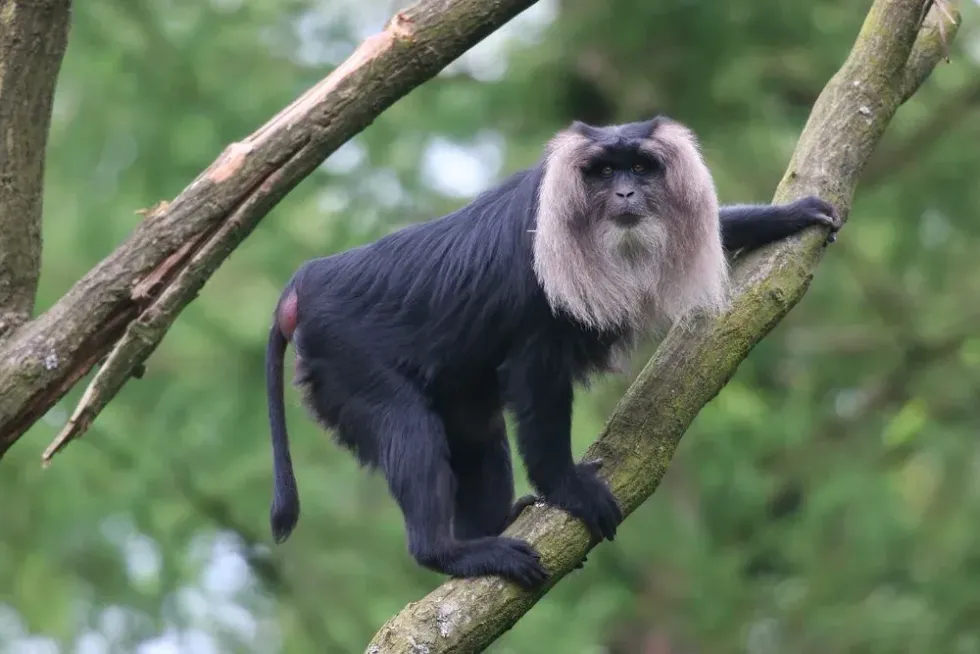Did you love watching the popular Disney movie 'The Lion King'? If so, then you will love knowing about the lion-tailed macaque!
This monkey was an advisor to the lion king Simba, and his father Mufasa, and now, you can know all about this majestic creature. Its name has been given after its tail which is shaped after that of a lion.
The lion-tailed macaque is found in South India, and the lion-tailed macaque adaptations are multiple in number to sustain their population in the wild. These monkeys are usually found in a group in the wild, of up to 20-30 individuals.
If you see them, however, you must not disturb them! They can be aggressive and attack anyone who comes too close, especially if you threaten the babies in the group.
These populations are best observed from a distance, where you can take pictures as well as view them without disturbing these majestic creatures. If you wish to read and know more about them, continue on, and do not forget to also check out red-tailed monkey facts and ring-tailed lemur facts for more fun with the monkeys!
Lion-Tailed Macaque Interesting Facts
What type of animal is a lion-tailed macaque?
The lion-tailed macaque, Macaca silenus, is a type of monkey.
What class of animal does a lion-tailed macaque belong to?
The lion-tailed macaque, Macaca silenus, belongs to the class of mammals.
How many lion-tailed macaques are there in the world?
According to a recent IUCN assessment, the population of these species is 3000–3500. These creatures spread across Kerala, Tamil Nadu, and Karnataka in India. Because lion tailed macaques reproduce well during captivity, there are now 500 of them in zoos across the world. In contrast, the population range of howler monkeys is around 100,000 in the wild.
Where does a lion-tailed macaque live?
Lion tailed macaques live in tropical rainforests throughout the south of India. Only the Western Ghats mountains in India are known to make up the lion-tailed macaque habitat.
What is a lion-tailed macaque's habitat?
Semi-evergreen and evergreen rainforest, as well as monsoon forests, are home to Macaca silenus. Usually, the lion-tailed macaque is found alongside deciduous trees and can be observed at elevations of up to 4921.3 ft (1500 m). Southern pig-tailed macaques can be found in the Malay Peninsula's southern half forest, Sumatra, including Bangka Island. They prefer to inhabit thick rainforests.
Who do lion-tailed macaques live with?
Lion-tailed macaques are diurnal and arboreal. They travel as a family group of 10-20 members or more than that. Although some groups contain up to three mature males, there is usually just one dominant male that is in charge of breeding.
How long does a lion-tailed macaque live?
In captivity, the Macaca silenus can live up to 38 years, while it is more common for them to live to be around 30 years old. The expected maximum life expectancy in the wild is around 20 years.
How do they reproduce?
Fertile females have a visible bulge underneath their tails. Males will know it's time to mate when they see this. There is no specific breeding season and for most of the time, lion-tailed macaques breed with each other. In February-March, the majority of babies are born.
Males reach sexual maturity at the age of eight, while females attain sexual maturity only at age of four. Females spend their entire lives in the natal group. Young males form bachelorette groups and then attempt to take over established groups.
What is their conservation status?
According to the IUCN Red List, the lion-tailed macaque (Macaca silenus), an inhabitant of the Western Ghats, has been declared an Endangered species.
Lion-Tailed Macaque Fun Facts
What do lion-tailed macaques look like?
Black fur covers the entire body. The tail is thin, long, naked, and also has a black crest at the tip, comparable to that of a lion's tail, albeit the lion's tail is more prominent in males than females.
The face is completely bare and dark. The cheek pouches of lion-tailed macaques emerge beside the bottom jaw and radiate outwards the side of the neck. After two months of age, the delicate, black pelage on offsprings is supplanted by adult pelage.
How cute are they?
They are not very cute animals. They are very fearsome creatures and should be stayed away from.
How do they communicate?
Males macaques have been the only macaques that use vocalizations to announce territorial boundaries. Male macaques are highly territorial, and they usually deliver a loud call to let intruding groups know they've arrived.
When two groups meet, one usually flees without displaying any overt aggressiveness. Their tail also plays an important role in their communication. Animals who are higher in the ranking have its tail up straight, while animals that are below in the hierarchy and fearful have tails pointing down.
How big is a lion-tailed macaque?
The average length of lion tailed macaques is 15.75-24.02 in (40-61 cm). While the Japanese macaque is 32.67 in (82.98 cm) long. Thus the lion-tailed macaque is smaller than the Japanese macaque.
How fast can a lion-tailed macaque move?
The traveling speed of these wild creatures is unknown due to a lack of investigation.
How much does a lion-tailed macaque weigh?
Lion-tailed macaque males weigh between 11.02-22.04 lb (4.99-9.99 kg), while females weigh just 6.61-13.2 lb ( 2.99-5.98 kg).
What are the male and female names of the species?
The male and female lion-tailed macaque (Macaca silenus) have no distinct names.
What would you call a baby lion-tailed macaque?
Kids of lion-tailed macaques do not have any particular name. They can be referred to as infants.
What do they eat?
Although lion-tailed macaques are omnivores, they eat mostly fruit. They eat a wide range of vegetation as their food, including leaves, flowers, stems, fungi, and buds, among other things.
The lion-tailed macaque diet also includes insects, tree frogs, lizards, and smaller animals on occasion. Because they are afraid of predators, lion tailed macaques tend to forage fast in the forest.
In times of peril, their cheek pouches allow them to rapidly gather massive amounts of food. When completely expanded, the cheek pouches can hold the same amount of food as their stomach!
Are they dangerous?
These species typically elude humans if possible. Agricultural farms including orchards may be attacked by these macaques.
Would they make a good pet?
Lion-tailed macaques have become an endangered species, their habitat only being in the Western Ghats of Southern India, where they live in the evergreen forest. To keep a species that thrives in such a diverse ecosystem, the confined environment should be equally diverse. It's challenging to keep such a large pet at home in a suitable environment.
Did you know...
This macaque has black hair. Its most distinguishing feature is a silver-white mane that wraps around the head from the cheeks to the chin, earning it the name 'beard ape.' The hairless forehead has a dark complexion.
Why is the lion-tailed macaque endangered?
The spectacular lion-tailed macaque is an Old World monkey with a lion-like tail that is lengthy, slender, and curled. Unfortunately, this cute primate is one of the most endangered macaques on the planet. Meanwhile, this primate is among the world's tiniest macaque species.
Habitat loss is a problem for lion-tailed macaques due to timber harvesting, firewood, and other forestry products destined for human consumption. They are also prone to inbreeding because of low numbers in the environment and the separation of different units in small forest patches.
Stopping development into lion-tailed macaques areas, as well as poaching, electrocution, and road-kills are all part of government strategy.
Why are lion-tailed macaques important?
Lion-tailed macaques are expected to have a role in seed distribution due to their frugivory and ability to bring fruits in their enormous cheek pouches. Lion-tailed macaques, as prey species, may have a favorable impact on the population of their predators.
Here at Kidadl, we have carefully created lots of interesting family-friendly animal facts for everyone to discover! Learn more about some other mammals from our colobus monkey facts and spider monkey facts pages.
You can even occupy yourself at home by coloring in one of our free printable Lion tailed macaque coloring pages.









